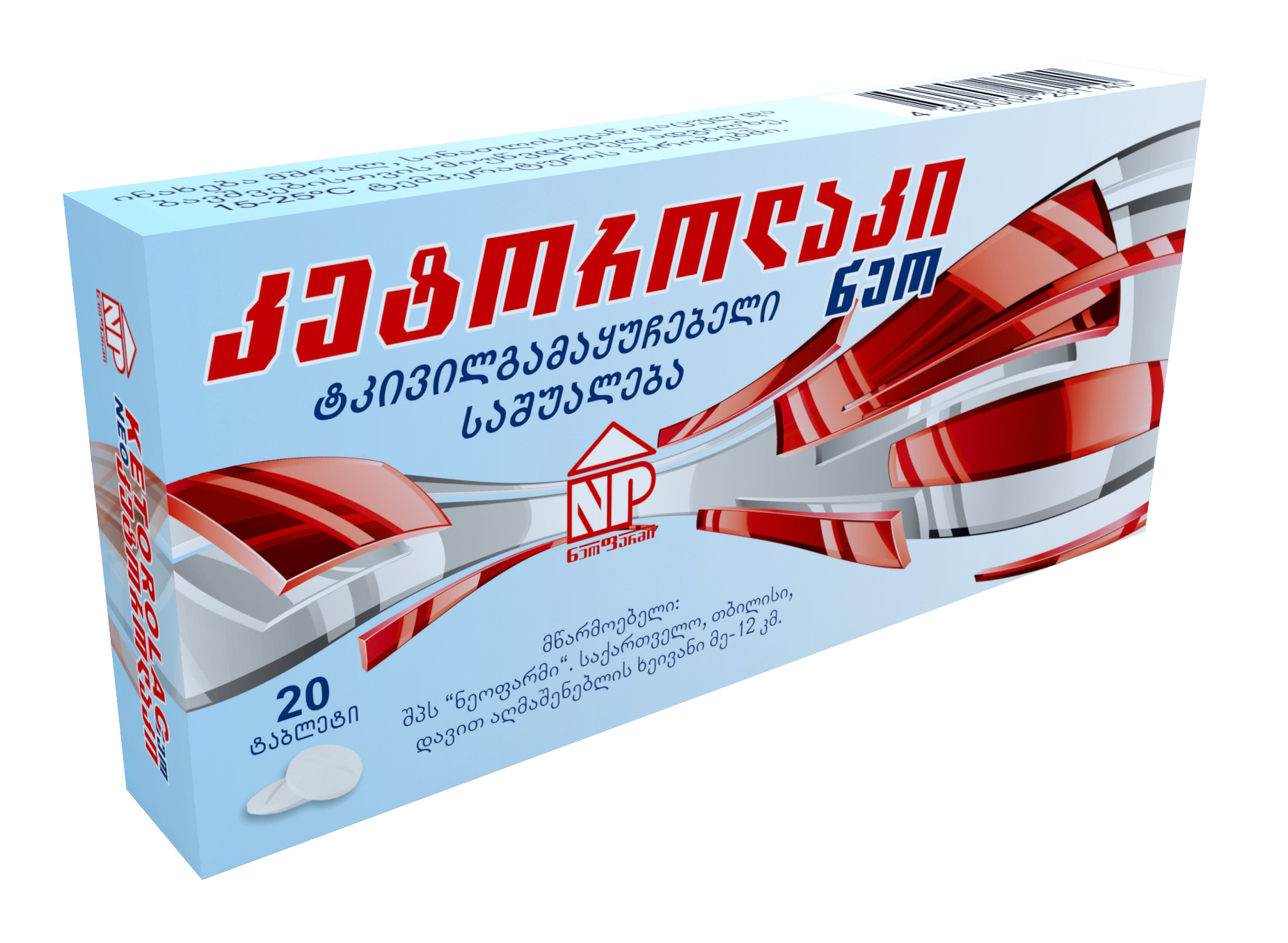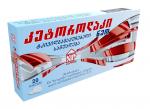Ketorolac-Neo #20 tab
 Nonsteroid anti-inflammatory mean
Nonsteroid anti-inflammatory mean
Generic name: Ketorolac.
ATС Code: MO1AB15.
Drug form: Tablets.
Pharmacological group: Nonsteroid anti-inflammatory means.
Composition: Active substance: Ketorolac
trometamine – 10mg;
Aiding substances: Lactose, starch, calcium stearate, aerosil.
Pharmacological operation:
Pharmacodynamics: Ketorolac reveals anti-inflammatory, analgesic
and febrifuge effect. Mechanism of action is determined by the selective competitive inhibition of
enzyme cyclooxygenase (mostly in peripheral tissues) and
prostaglandins’ – edema,
inflammation and pain mediator synthesis suppression.
Ketorolac represses thrombocyte aggregation, prolongs
bleeding period. Functional state of thrombocyte restores after preparation
remove within 24-48 hours.
Ketorolac doesn’t act on opioid receptors. It doesn’t
suppress breath, digestion tract
motility, doesn’t characterize sedation and
anxiolytic action, doesn't influence work of cardiac muscle, and doesn’t cause
hemodynamic changes and drug dependence. Analgesic effect reveals after 0,5-1 hours from intake and lasts for
1-2 hours.
Pharmacokinetics: After peroral intake, Ketorolac is
absorbed quickly and completely. Bioavailability makes up 80-100%. At time of
preparation intake (10 mg.) on fasting, maximum concentration (0,7-1,1 mkg/ml)
in blood plasma is reached in 40 minutes. Food intake has no impact on
absorption quality. However, fat-rich food reduces and prolongs maximum
concentration reach in the blood up to 1 hour.
Semiejection period of the preparation makes up 5 hours on average. 99%
of Ketorolac relates to plasma proteins.
Ketorolac metabolizes in the liver by formation of conjugate with glucuronic
acid, which don’t have analgesic action. 90% of the taken dose is excreted with
urine, herewith 60 % - unchanged form. Pharmacokinetics changes in ageing people and patients having kidneys’ function disorder. In ageing people
preparation clearance decreases
and semiejection period increases up to 6 hours on average. Preparation
excretion decreases in those patients who have kidneys’ function disorder,
followed by general clearance reduction and semiejection period increases up to
9-10 hours. Ketorolac passes placental barrier
with small concentration, also transfers into breast milk.
Indication: Relief of various genesis pains, among them:
· Posttraumatic pain (at time of retraction,
fracture, dislocation, soft tissues injury);
· Postoperative pain (at time of abdominal
cavity, gynecological and orthopedic
operations);
· Pain in the post-natal period;
· Toothache, among them pain after dental
interference;
· Acute pain at time of osteochondrosis, arthralgy, radiculitis, ischialgia
and various pathologies of the tissues;
· Pain at time of oncologic diseases;
The preparation isn’t used at time of chronic
pain syndrome.
Contraindications: Hypersensitivity toward Ketorolac and nonsteroid anti-inflammatory means; nasal
pollinosis syndrome; angioneurotic edema, different origin
hypovolemia and dehydration; stomach and duodenum erosive–ulcerative damage; cerebrovascular disorders;
moderate and expressed disorders of kidney function; postoperative period with
bleeding danger; blood coagulation disorder; intake together with other
nonsteroid anti-inflammatory means; heavy insufficiency of heart; delivery
pain; delivery current.
Order of intake and dosage: “Ketorolac
Neo” dosing regimen is established individually, taking into account the
expression of pain syndrome. Duration of treatment should not exceed 7 days. In
adults and adolescents over the 16 years is taken 10 mg (1 pill) in each 4-6
hours. In case of severe pain, the dosage can be increased up to 20mg. Maximum
round-the-clock dosage makes up 90mg.
Dosage should be decreased for those patients, who are more that 65
years; body weight less than 50kg. or kidney function disorder (maximum
round-the-clock dosage makes up 60mg.)
Side effects: At reception of “Ketorolac Neo” may reveal
following side effects:
From the side of central nervous
system: headache, dizziness, feeling of weakness, asthenia, drowsiness, increased nervous
excitability, depression.
From the side of respiratory system: bronchismus, rhinorrhea, dyspnea,
sinusitis, rhinitis.
From the side of digestion
system: nausea, diarrhea, dyspepsia,
pain in the abdominal cavity, mouth dryness, stomach erosion ulcerative damage, bleeding, and ulcer
perforation.
Allergic reactions: rash on skin, nettle-rash,
itch, various localization angioneurotic edema, Stevens-Johnson syndrome;
Laboratory indicators: there may be developed eosinophilia, increase of
liver transaminase activity.
Special instructions:
"Ketorolak Neo" is
recommended to intake during the short period.
As elimination speed of Ketorolak is reduced at elderly patients, the
preparation is prescribed in small doses and under supervision of the doctor.
Preparation is prescribed carefully for those patients who have heart
insufficiency, together with anticoagulants.
It is necessary to control patients with blood coagulation disorder
continuously.
During treatment period by the preparation, it is important to control
function of kidneys.
Pregnancy and lactation: Ketorolak passes placental barrier with small
concentration and penetrates into the chest milk. Preparation reception is
allowed during pregnancy, only the doctor’s prescription and only when
potentially result useful for mother sharply exceeds to the potential risk of
the fetus.
In case of necessity of
"Ketorolak Neo" during lactation, there should be stopped breast
feeding.
Application in pediatrics: It isn't recommended to use the preparation at
children's age.
Interaction with other medicines or other sort interaction: It isn’t recommended to use
"Ketorolak Neo" together with other nonsteroid anti-inflammatory means, because risk of developing side-effects
increases.
“Ketorolak” slightly reduces Varfarin plasma
connection with proteins.
"Ketorolak Neo's" reception together
with furosemide, reduces diuretic effect approximately 20%.
Probenecid reduces “Ketorolak” plasma clearance
and distribution volume, which causes increase of its concentration and semiejection period in plasma.
Against the background of “Ketorolak” intake
there reduce clearance of methotrexate, litiya and risk of their toxicity
increases. At reception together with
AGF-inhibitors the risk of kidneys’ injury increases. Preparation reception together with
psychostimulants, can cause hallucinations.
Overdose: Symptoms: Abdominal
pain, nausea, vomiting, stomach erosive-ulcerous injury, tachypnoe, liver function disorder.
Treatment: Treatment is symptomatic, gastric lavage is recommended; intake of
activated carbon or other adsorbent.
Influence of vehicle and mechanisms management: Those patients, in whom reception of
nonsteroid anti-inflammatory means causes dizziness and drowsiness,
should abstain from management of motor transport and mechanisms during
treatment by "Ketorolak Neo".
Package: 10 tablets on polyvinyl chloride blister, 2 blisters in the carton box.
Storage conditions: Store on 15-25ºC temperature in a dry, protected
from light place and keep away from children.
In case of visual defects and expiry of validity date, the preparation
can not be used.
Order
of issue: III group of a
pharmaceutical product, issued without a
doctor's prescription.
Validity: 2 years.
Manufacturer:
Ltd “Neopharmi”.
12th km, David Agmashenebeli alley,
Tbilisi, Georgia
Tel/Fax: +995 (032) 259-64-46; 259-57-90.


